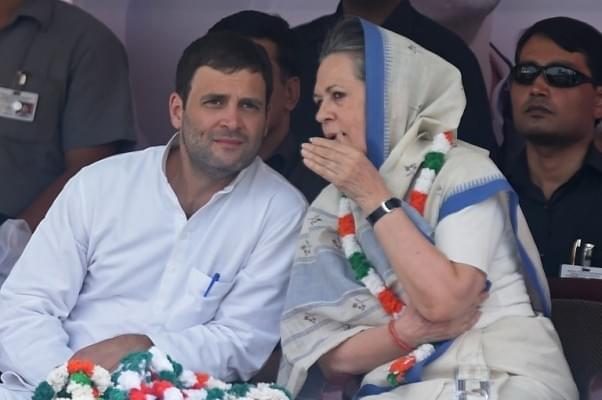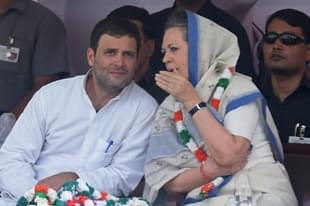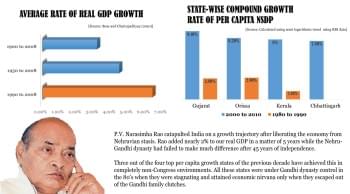Politics
Freedom From The Congress Dynasty: Sooner The Better For States
Praveen Patil
Aug 21, 2015, 09:55 PM | Updated Feb 12, 2016, 05:24 PM IST
Save & read from anywhere!
Bookmark stories for easy access on any device or the Swarajya app.


How the states of India suffered under the rule of Congress’ dynasty, and how they are now resurrecting.
Despite Indira Gandhi’s popularity even in the early stages of her Prime Ministership, by the 1967 Jabalpur AICC session it was clear that there were 5 major factions within the Congress party.
The first group was the ‘Kitchen Cabinet’ of the PM, the second group was the ‘Syndicate’ (a group of regional Congress stalwarts) and then there were 3 other groups made up of followers of powerful union ministers – Deputy PM, Morarji Desai, Y.B. Chavan and Babu Jagjivan Ram respectively. K. Kamaraj, the then president of the Congress party was already reduced to being a “stateless leader” and derived his strength mainly from the Syndicate.
Arguably, K. Kamaraj was the last Congress President who had all three traits of the supposedly Gandhian template of good leadership – democratic mandate (of the party), gravitas and the humility to objectively assess one’s own limitations. Consequently, Kamaraj steadfastly refused another term of Congress presidency despite overwhelming support from most factions of the party.
The 1968 Congress presidential election was the last time when there was clear consultation of rank and file following the well-established democratic procedural practices. The mild-mannered Karnataka Chief Minister, S. Nijalingappa, followed Kamaraj as the compromise candidate of all the factions for party presidency.
It is not coincidental that both Kamaraj and Nijalingappa were South Indians. 1968 was that inflection point in India’s political history when all the prescribed ethical parameters were dissolved forever even as politics acquired its ‘dirty’ dimension.
Whatever Mrs. Gandhi was or was not, she definitely was the first Indian politician who introduced the concept of “take no prisoners” into Indian polity. Her inherent philosophy was based on a linear thought process of power politics without any disruptions of ideology or governance enhancements.
Indira’s naked ambition was new to India then, and the genial South Indian politicians became the first casualty of her linear goals. The post-independent domain of (non-Hindi) language politics too had run its course by the 1970’s and the south Indian states were going through a demographic churning aimed towards a progressive equity dilution of the freedom movement. The rise of communism in Kerala and the Dravidian movement of Tamil Nadu were precursors to the larger change that would come about in the form of Janata-Hegde experiment in Karnataka and TDP’s ascendancy in AP at the beginning of the 80’s.
Thus, the southern hemisphere of India had started to unshackle itself from debilitating central Congress control nearly two decades before the purely caste empowered Mandal churning of north India. In fact, the change was so deep-rooted that even the Congress party was forced to adapt to newer electoral realities beyond the Gandhi dynasty which is why some of the best administrators that the Congress has produced in the last 4 decades have mostly been south Indian leaders – P.V. Narasimha Rao, S.M. Krishna and Y.S. Rajashekhar Reddy to name a few.
The impact of breaking out of the clutches of the Nehru-Gandhi family control was life-altering for south India. After Indira Gandhi’s return to power, throughout the 1980’s, Congress party indulged in unbridled communalization of polity along with blatant division of the populace through caste structures like KHAM (Kshatriya-Harijan-Adivasi-Muslim).
Throughout these dark years, south Indian political administration kept distancing itself from the Gandhi family control to grow on a different trajectory. Better governance models adopted by the southern states yielded tangentially different results. In fact, data clearly shows that the demographic dividend of southern Indian states was directly proportional to the speed with which they untangled themselves from the dynasty!

Since the turn of the millennium, north Indian states have slowly started emerging as the new growth geographies, but here too drastic alteration of governance was directly proportional to the distance these states travelled away from the Gandhi dynasty. For instance, Bihar, that ever burgeoning wasteland of 20th century, broke out of the Jungle raj complexities only when Gandhi dynasty loyalist Lalu Prasad Yadav’s RJD was finally thrown out of power in 2005. Similarly, Madhya Pradesh began its growth trajectory only after getting out of the clutches of Digvijay Singh (another die-hard dynasty sycophant) in 2003.

In fact, Digvijay Singh’s home state Madhya Pradesh is a clear example of what a state can achieve once it goes beyond the dynastic control. Even as the first family of Congress party stalled parliament throughout the monsoon session in the name of Vyapam in July-August this year, the voters of the state reposed full faith on the ruling party last week when BJP won 8 out of 10 local bodies while Congress managed to scrape through in only one Nagarpalika. The reason for this stupendous achievement by BJP lies in the economic realities of the state.
Madhya Pradesh, a once BIMARU state, had a per-capita income of 14471 rupees in 2004-05 (after 10 years of Congress rule) which increased by a mind-boggling 250% during the decade-long non-dynastic BJP rule to 54030 rupees in 2013-14. What is more, from being a total agrarian failure for nearly 6 decades, Madhya Pradesh has been transformed into a wheat bowl of India along the lines of prosperous Punjab. Madhya Pradesh’s GDP Income from farm sector in 2004-05 was 31238.30 crore rupees which had seen a gravity defying 121% jump in 2013-14 to 69249.89 crore rupees in less than a decade.
Indeed Madhya Pradesh’s agricultural miracle provides us with a great contrast of an India which was suffering throughout the decade of decay during the Sonia Gandhi-led UPA 1 and UPA 2 years when India’s agrarian growth always hovered at a pathetic 1-3% range. It was in this same era that Madhya Pradesh achieved the impossible. For instance in 2013-14, MP achieved a whopping agrarian growth of 24.99%! Mind you, this incredible growth in a single year actually came over a huge base, for in 2012-13 this rate was 20.16% and in 2011-12 it was 19.85%.
These successes at the state level are spread out everywhere. In the western hemisphere, Gujarat is another miracle economy because it has shunned the Gandhis for more than 2 decades now. Even in neigbouring Maharashtra, the administrative processes have mostly remained outside the purview of Gandhi family control. Whatever the shortcomings of Sharad Pawar, one of his achievements has been to keep vast swaths of Maharashtra away from the Gandhi total control at least since the 1990’s.
Perhaps the biggest example of India’s potential destiny even when temporarily cured of the Gandhi disease comes from the P.V. Narasimha Rao years. For nearly 4 and a half decades before 1991, India was constantly mocked for its ‘Hindu’ rate of growth, but the moment the national government was liberated of the dynastic control, in five years India took giant steps towards socio-economic nirvana under a visionary Prime Minister who was later shunned by the Gandhi family for altering India’s destiny!

It is indeed a telling comment on the Gandhi family that they managed to take out the same finance minister Manmohan Singh away from Narasimha Rao’s vision and managed to give us a decade of decay under the careful guidance of Sonia Gandhi. When this very same Sonia Gandhi walks into the well of the parliament and clenches her fist against the Indian electorate for giving a former chaiwala the mandate, it must not worry us as a nation. When the latest dynastic scion, Rahul Gandhi, wants to save “Indians from Modi”, it must relieve us even further. When the Gandhi-pliant Lutyens media constantly wants Modi to fail and Rahul to succeed, the situation must really be good.

The Gandhi situation is indeed pitiable in today’s India. It is a bottom-up resistance to Gandhis that had once begun at the state level and then rose to a national cure in the form of 2014’s Modi victory which has rendered the dynasty virtually into a non-entity. The truth is that the Gandhi disease is fast running out of host states to grow on as state after state rejects Gandhis and everybody associated with them.
Analyst of Indian electoral politics and associated economics with a right-of-centre perspective.




